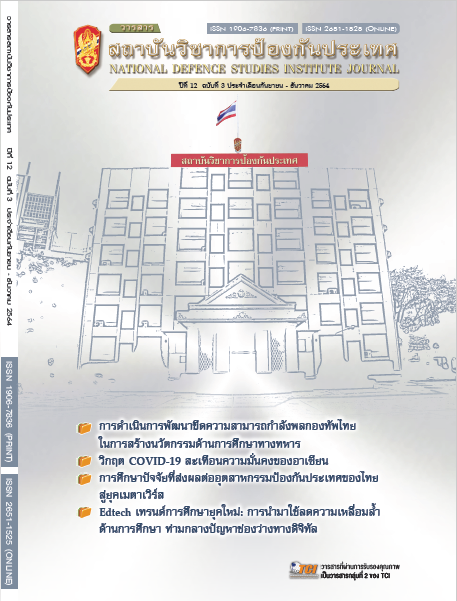Edtech-Trend of Modern Learning: Implementation to Reduce Educational Inequality amid Digital Divide
Main Article Content
Abstract
The paper “Edtech-Trend of Modern Learning: Implementation to Reduce Educational Inequality amid Digital Divide” aimed to demonstrate the problem and obstacle in the implementation of Edtech to solve educational inequality in Thailand, and to present solutions to the issues--“digital divide” resulting from the difference in livelihood and remoteness of students in each area. These factors result in the unequal potential of each student in the access to digital technology that includes Edtech. Therefore, the solution to such the problems requires integrated collaboration from all sectors including public and private sectors, foundations, associations, and funds with integrity to reduce the digital divide in Thai society. The proposed approach is to establish facilities covering all areas: 1) basic infrastructure which includes electricity, the Internet and telecommunication network, 2) device which includes computer, notebook, and tablet, and 3) operating skills that will pave the way for Edtech to reduce the educational gap in Thailand efficiently and effectively.
Article Details

This work is licensed under a Creative Commons Attribution-NonCommercial-NoDerivatives 4.0 International License.
The articles, images, tables, graphs, written content, and opinions published in this journal are solely those of the authors and do not necessarily reflect the views or positions of the National Defence Studies Institute or its academic affiliates.
References
กองทุนเพื่อความเสมอภาคทางการศึกษา. (2564). กสศ.- ธนาคารโลก ห่วงปัญหาความเหลื่อมล้ำการศึกษาพุ่งชี้ต้องเร่งยกระดับคุณภาพ รร.อย่างทั่วถึงและมีมาตรการพิเศษ. สืบค้นเมื่อ 1 พฤศจิกายน 2564, จาก https://www.eef.or.th/news-eef-world-bank-raise-the-quality-of-the-school/
คาฮูท (kahoot) เกมทดสอบความรู้. (2563). สืบค้นเมื่อ 23 ธันวาคม 2564, จาก http://www.thaiall.com/quiz/kahoot/
คิดเห็นแชร์: นโยบายการเข้าถึงระบบไฟฟ้าในพื้นที่ห่างไกล (เกาะ,ดอย) ประเทศไทยควรทำอะไรบ้าง? โดย ดร.ทวารัฐ สูตะบุตร. (2563, 15 สิงหาคม). มติชนออนไลน์. สืบค้นเมื่อ 1 พฤศจิกายน 2564, จาก https://www.matichon.co.th/economy/news_2307393
จีรณา น้อยมณี , ณัฐฐา สักกะวงศ์, ณัฐวัฒน์ วรสิทธิ์ตระกูล และณัฐกิตติ์ จิตรเอื้อตระกูล. (2563). AI Government Framework. กรุงเทพฯ: สำนักงานพัฒนารัฐบาลดิจิทัล (องค์การมหาชน).
จุธาทิพย์ จิตต์เจริญ. (2558). การพัฒนาผลสัมฤทธิ์ทางการเรียนวิชาการค้าปลีกของนักเรียนระดับประกาศนียบัตรวิชาชีพ ชั้นปีที่ 3/1 สาขาวิชาการตลาดโดยใช้วิดีโอช่วยสอน “รายการ SME ตีแตก” (งานวิจัยในชั้นเรียน วิทยาลัยเทคโนโลยีอักษรบริหารธุรกิจ จังหวัดระยอง).
ณรัณภัสสร์ ฐิติพัทธกุล. (2563). Edtech ปฏิรูปความเหลื่อมล้ำได้จริงหรือ?? กรณีศึกษาจากประเทศอาร์มีเนีย ประเทศที่มีความเหลื่อมล้ำมากกว่าไทยถึง 10 เท่า. สืบค้นเมื่อ 1 พฤศจิกายน 2564, จาก https://www.disruptignite.com/blog/dasaranedtech
นรรัชต์ ฝันเชียร . (2562). การจัดการศึกษาแบบห้องเรียนเสมือน. สืบค้นเมื่อ 22 ธันวาคม 2564, จาก https://www.trueplookpanya.com/education/content/76903/-teaartedu-teaart-teamet-
_______. (2563). Edtech ธุรกิจใหม่ของการเรียนรู้ในช่วง COVID-19. สืบค้นเมื่อ 1 พฤศจิกายน 2564, จาก https://www.trueplookpanya.com/education/content/84365/-teaartedu-teaart-
ปิยะธิดา ปรางค์โคกกรวด. (2564). Education Technology (Edtech). สืบค้นเมื่อ 1 พฤศจิกายน 2564, จาก https://www.lib.ku.ac.th/2019/index.php/research-support/info-deedee/1387-edtech
พิมพันธ์ เดชะคุปต์. (2560). ทักษะ 7C ของครู 4.0. กรุงเทพฯ: โรงพิมพ์แห่งจุฬาลงกรณ์มหาวิทยาลัย.
วรัตต์ อินทสระ. (2562). Game Based Learning-The Latest Trend Education 2019-เปลี่ยนห้องเรียนเป็นห้องเล่น. กรุงเทพฯ: มหาวิทยาลัยสวนดุสิต.
ศูนย์วิจัยกสิกรไทย. (2564). EdTech นวัตกรรมนำเทรนด์ การศึกษาโลก. สืบค้นเมื่อ 30 ตุลาคม 2564, จาก https://kasikornresearch.com/th/analysis/k-social-media/Pages/Ed-Tech-06-07-21.aspx
สำนักงานสถิติแห่งชาติ. (2564). การสำรวจการใช้เทคโนโลยีสารสนเทศและการสื่อสารในครัวเรือน พ.ศ.2564 (ไตรมาส 2).กรุงเทพฯ: สำนักงานสถิติแห่งชาติ กระทรวงดิจิทัลเพื่อเศรษฐกิจและสังคม
สำนักงานเลขาธิการสภาการศึกษา. (2560). แผนการศึกษาแห่งชาติ พ.ศ.2560-2579. กรุงเทพฯ: สำนักงานเลขาธิการ สภาการศึกษา กระทรวงศึกษาธิการ
เอ็นไอเอ หนุน 'เอ็ดเทค' ลดความเหลื่อมล้ำการศึกษาไทย . (2564, 25 มิถุนายน). กรุงเทพธุรกิจ. สืบค้นเมื่อ 1 พฤศจิกายน 2564,เข้าถึงได้จาก https://www.bangkokbiznews.com/tech/945325
Barron, S. (2020). What Is a Virtual Classroom?. Retrieved November 22, 2021 from https://resources.owllabs.com/blog/virtual-classroom
Hilbert, M. (2011). The end justifies the definition: The manifold outlooks on the digital divide and their practical usefulness for policy-making. Telecommunications Policy, 35(8), 715-736.
Simplilearn. (2021). What is Blockchain Technology and How Does It Work?. Retrieved November 22, 2021,from https://www.simplilearn.com/tutorials/blockchain-tutorial/blockchain-technology#what_is_blockchain_technology
Siwaporn Linthaluek. (2563). แนะนำการใช้งาน Zoom ในการจัดการเรียนการสอนออนไลน์. สืบค้นเมื่อ 22 ธันวาคม 2564, จากhttps://www.youtube.com/watch?v=QJ9IIHrwSKE&ab_channel=SIWAPORNLINTHALUEK
Video-Assisted Learning: Worth a Million Words. (2020). retrivevd December 22, 2021 from https://myviewboard.com/blog/education/video-assisted-learning/


